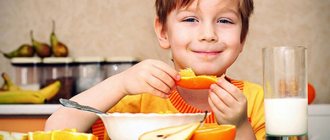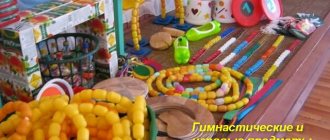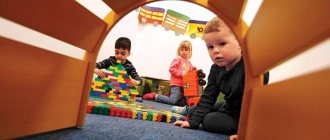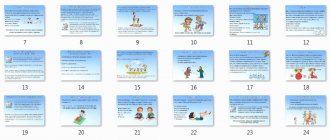Diet in kindergarten
Meals in kindergartens are designed taking into account the age characteristics of the child. The norm for nursery groups is 155 kcal, for older children - 1900 kcal per day. Nutrition standards for preschool institutions were developed by the Institute of Nutrition of the Russian Academy of Medical Sciences.
The menu is designed in such a way that dishes are not repeated within 20 days. Agree, such a varied diet at home is rare, especially for working mothers.
Products are supplied by supplier companies that undergo a competition. The company that wins the tender enters into a contract with the preschool educational institution.
Thus, the supplier brings fresh products to the kindergarten, and there the cook prepares the food on site. Moreover, dishes must be prepared immediately before consumption: food that has stood for more than 2 hours is already considered stale.
Your daily diet should include:
- meat;
- milk;
- dairy products;
- bread;
- potato;
- fruits;
- cereals;
- vegetables;
- butter and vegetable oil;
- drinks (juices, cocoa, compotes).
Other products (fish, cottage cheese, eggs, cheese, etc.) - 2 - 3 times a week.
Dishes can be replaced with identical ones. For example, chicken can be replaced with turkey, beef, rabbit meat; fish - seafood, some vegetables can be replaced with others, etc. The main thing is that the number of calories when replacing corresponds to the norm.
For children with allergies, foods that cause food allergies are excluded.
Attention! Children are prohibited from giving food that has not undergone heat treatment, except for salted herring, trout and salmon. Also, their diet should not contain canned food, pickled vegetables, mushrooms, wild animal meat, dairy products with vegetable fats, cream confectionery, carbonated drinks, fried and spicy foods.
Also read on our website: Is it possible to remove belly fat after childbirth?
Do you want to know who you are for your child - a friend or a teacher? Find out HERE!
The legislative framework
Meals in preschool institutions are organized using standards determined by law.
All of them are recorded in a regulatory document issued by the Chief Sanitary Doctor of Russia No. 26.
This document establishes a number of specific requirements put forward for the construction of the food supply process in kindergartens:
- Appendix No. 11 - determines the list of food products required for consumption on the menu in a preschool institution throughout the week;
- Appendix No. 10 – records the list of products required for each child attending kindergarten;
- Appendix No. 9 - contains a list of products unsuitable for children's food, the use of which is prohibited.
Meals in preschool institutions are organized using standards determined by law.
Diet in kindergarten
In accordance with SanPiN, meals for children are organized in a group at least 4 times (breakfast, second breakfast, lunch, afternoon snack). Some gardens also offer dinner.
The interval between meals is no more than 4 hours.
Optimal meal times in kindergarten:
- 8.30 - 9.00 - breakfast;
- 10.30 - 11.00 - second breakfast;
- 12.00 - 13.00 - lunch;
- 15.30 - 16.00 - afternoon tea;
- 17.00 - 17.30 - dinner.
Meal times fit organically into the general daily routine in kindergarten.
Every day the group posts a menu indicating the name of the dish and serving size, as well as substitutions for children with allergies and diabetes.
Regulations on the organization of meals for pupils
3.8.Development of measures on the organization of balanced, healthy nutrition in preschool educational institutions.
4. Requirements for organizing meals for pupils in preschool educational institutions, including disabled people and persons with limited health capabilities.
4.1. The organization of catering is the responsibility of the administration of the preschool educational institution. The distribution of responsibilities for organizing meals among catering workers, teachers, and teaching assistants is determined by order.
4.2. The head of the preschool educational institution is responsible for organizing meals and supervising the work of employees.
4.3. When transporting food products, it is necessary to observe conditions that ensure their safety, protect them from contamination, taking into account the sanitary and epidemiological requirements for their transportation.
4.4. Acceptance of food products and food raw materials at preschool educational institutions is carried out in the presence of shipping documents confirming their quality and safety (food delivery statement, invoice, quality certificate, and, if necessary, a veterinary certificate). The products are supplied in the manufacturer's (supplier's) containers. Documentation certifying the quality and safety of products, marking labels (or copies thereof) are retained until the end of product sales. Incoming control of incoming products (rejection of raw products) is carried out by a responsible person. The control results are recorded in a special journal. Food products with signs of poor quality are not allowed, as well as products without accompanying documents confirming their quality and safety, and without labeling, if the presence of such labeling is provided for by the legislation of the Russian Federation.
4.5. Food products are stored in accordance with their storage conditions and expiration dates established by the manufacturer in accordance with regulatory and technical documentation. Warehouses for storing food products are equipped with instruments for measuring air temperature, refrigeration equipment - with control thermometers.
4.6. The design, equipment and maintenance of the catering unit of the preschool educational institution must comply with the sanitary rules for public catering organizations.
4.7. All technological and refrigeration equipment must be in working order.
4.8. Technological equipment, inventory, utensils, and containers must be made of materials approved for contact with food products. All kitchen equipment and cookware must be labeled for raw and prepared foods.
4.9. Electrical equipment, an electric stove, is used for cooking.
4.10. The catering unit is subject to daily wet cleaning and general cleaning according to the approved schedule.
4.11. Food service workers undergo medical examinations and examinations, professional hygienic training, must have a personal medical record book, where they enter the results of medical examinations and laboratory tests, information about vaccinations, previous infectious diseases, and information about undergoing professional hygienic training.
4.12. Every day, before starting work, the responsible person inspects workers involved in the preparation and distribution of food for the presence of pustular diseases of the skin of the hands and open surfaces of the body, as well as tonsillitis, catarrhal phenomena of the upper respiratory tract. The inspection results are recorded in a special journal. Sick employees or suspected infectious diseases are not allowed or immediately suspended from work. Food service workers who have cuts or burns on their hands are allowed to work on preparing food and distributing it if they wear gloves.
4.13. While working, food service workers should not wear rings, earrings, pin their work clothes with pins, or eat or smoke in the workplace or on the territory of the preschool educational institution.
4.14. A drinking regime must be organized in preschool educational institutions. It is allowed to use boiled drinking water, provided it is stored for no more than 3 hours.
4.15. To ensure a varied and nutritious diet for children in preschools and at home, parents are informed about the range of food for the child by posting the daily menu in each group cell. The daily menu indicates the name of the dish and the serving size.
5. Catering in preschool educational institutions
5.1. The organization of meals for pupils in preschool educational institutions requires compliance with the following basic principles:
- creating a complete diet;
- the use of a diverse range of products that guarantee a sufficient content of essential minerals and vitamins;
— strict adherence to a diet that meets the physiological characteristics of children of different age groups, its correct combination with the daily routine and operating hours of the preschool educational institution;
— compliance with the rules of food aesthetics, education of the necessary hygienic skills depending on the age and level of development of children;
- the correct combination of nutrition in preschool educational institutions with food at home, carrying out the necessary sanitary and educational work with parents, hygienic education of children;
— an individual approach to each child, taking into account the state of his health, developmental characteristics, adaptation period, chronic diseases;
— strict adherence to technological requirements when preparing food, ensuring proper culinary processing of food products;
- daily monitoring of the work of the catering unit, bringing food to the child, proper organization of nutrition for children in groups;
— taking into account the effectiveness of children's nutrition.
5.2. The preschool educational institution provides balanced 4 meals a day for children in groups with a 12-hour stay, in accordance with sanitary rules and regulations. When organizing meals, age-related physiological norms of daily requirements and the total volume of dishes per meal (in grams) are taken into account.
5.3. Meals in the preschool educational institution are provided in accordance with an approximate 20-day menu for the summer and autumn-winter-spring feeding periods for children of age categories from 1.5 to 3 and from 3 to 7 years old with a 10.5-12 hour operating mode of the preschool educational institution, developed by the Department education and youth policy of the Administration of the Voronezh urban district, approved by the Federal Service for Surveillance in the Sphere of Consumer Rights Protection and Human Welfare FBUZ “Center for Hygiene and Epidemiology of the Voronezh Region”.
5.4. In the absence of any products, in order to ensure a complete balanced diet, it is allowed to replace them with products of equal composition in accordance with the approved table of product replacement for proteins and carbohydrates (Appendix No. 14 to SanPiN 2.4.1. 3049-13).
5.5. Based on the approved sample menu, a menu is drawn up daily - a layout of the established sample, indicating the output of dishes for children of different ages. It is allowed to create menu layouts in electronic form. For children of different ages, the portion sizes of prepared dishes must be observed.
5.6. The menu requirement is the main document for preparing food in a catering unit.
5.7. It is prohibited to make changes to the approved menu layout without the approval of the head of the preschool educational institution.
5.8. Children's nutrition should comply with the principles of gentle nutrition, which include the use of certain methods of preparing dishes, such as boiling, steaming, stewing, baking, and excluding frying foods, as well as foods with irritating properties. When cooking food products, it is necessary to comply with established sanitary and epidemiological requirements for technological processes of preparing dishes.
5.9. In order to prevent hypovitaminosis, preschool educational institutions carry out year-round artificial C-vitaminization of ready-made dishes. Vitamin preparations are introduced into the third dish after cooling immediately before serving. Fortified dishes are not heated. Parents must be informed about vitaminization.
6. Organization of the catering department
6.1. The catering department is organized strictly in accordance with SanPiN 2.4.1. 3049-13.
6.2. Cooking is carried out in accordance with the technological map.
6.3. The issuance of prepared food is permitted only after acceptance control has been carried out by a rejection commission appointed by order of the head of the preschool educational institution. The control results are recorded in a special journal. Immediately after cooking, a daily sample of the finished product is taken. A daily sample is taken in volume: portioned dishes - in full; cold appetizers, first courses, side dishes, third and other courses - at least 100 grams. Store for 48 hours at t +2 -+6C in the refrigerator.
6.4. The grading of raw products is carried out in a special journal, as the products arrive and as they are sold (taking into account the shelf life and sale).
7. Organization of meals for pupils in groups
7.1. Work on organizing meals for children in groups is carried out under the guidance of a teacher and consists of:
- creating safe conditions when preparing and eating food;
— in developing cultural and hygienic skills when children eat.
7.2. The assistant teacher receives food for the group strictly according to the schedule approved by the head of the preschool educational institution. Finished products are hung on the catering unit in labeled containers and distributed into groups.
7.3. Involving children in receiving food from the catering unit is strictly prohibited.
7.4. Before distributing food to children, the assistant teacher must:
- wash tables with hot water and soap;
- wash your hands thoroughly;
— wear special clothing for receiving and distributing food;
- ventilate the room;
7.5. When setting the table, it is necessary to have separate dishes for the first and second courses, napkins, plates for bread, and cutlery in accordance with age.
7.6. The children's portion must correspond to the menu and control dish.
7.7. During the distribution of food, it is strictly prohibited for children to be in the dining area (except for those on duty).
7.8. In order to develop work skills and foster independence while on duty in the dining room, the teacher must combine the work of the attendants and each child (for example: the napkin holders are collected by the attendants, and the children clear the plates after themselves).
7.9. The teacher and children can eat at the same time.
7.10. In early age groups, children who have not developed the skill of eating independently are supplemented by a teacher and an assistant teacher.
7.11. Responsibility for organizing meals in the group, in accordance with these regulations and SanPiN 2.4.1. 3049-13 is carried by educators.
8. The procedure for recording meals in preschool educational institutions
8.1. By the beginning of the school year, the head of the preschool educational institution issues an order on the organization of meals, on the appointment of persons responsible for meals, and determines their functional responsibilities.
8.2. The person in charge of nutrition records the children who eat in the attendance sheet, which must be laced, numbered, sealed and signed by the head.
8.3. Every day, the person in charge of nutrition keeps a record of children eating and enters them into the attendance sheet based on the lists of children present from 08.00 to 08.30.
8.4. The preparation of breakfast products is carried out by the cook at 07.00.
8.5. Breakfast products are ordered according to the menu according to the attendance sheet of the previous day.
8.6. Products for the broth of the first course (for lunch) are written out according to the menu according to the attendance sheet of the previous day, the products are placed at 07.30.
8.7. The person in charge of food must be present when the main products are put into the cauldron and check the dishes at the exit.
9. Financing expenses for food for pupils in preschool educational institutions
9.1. The financial provision of food falls within the competence of the head of the preschool educational institution, the accountant of the nutrition department of the education and youth policy department of the administration of the Voronezh urban district.
9.2. The calculation of financing the cost of nutrition for pupils in preschool educational institutions is carried out on the basis of established nutritional standards and the physiological needs of children.
9.3. Food costs are financed from budget funds:
— 50% (basis Resolution of the administration of the city district of the city of Voronezh No. 19 dated 01/20/2016 with amendments dated 12/26/2018 Resolution of the AGO of the city of Voronezh No. 896):
— single mothers (fathers);
- if one of the parents (legal representatives) is a disabled person of group I or II;
- if both parents (legal representatives) are students receiving secondary vocational or higher education on a full-time (full-time) basis;
- if one of the parents (legal representatives) is a military serviceman undergoing military service;
- if one of the parents (legal representatives) is a participant in hostilities;
- if one of the parents (legal representatives) received or suffered radiation sickness; is a liquidator or evacuee from the exclusion zone as a result of the disaster at the Chernobyl nuclear power plant;
- widows (widowers);
- families in difficult social situations;
-if both parents (legal representatives) are teachers of a municipal educational institution in the urban district of Voronezh.
— 100% (basis Decree of the administration of the city district of the city of Voronezh No. 19 dated 01/20/2016 with amendments dated 12/26/2018 Decree of the AGO of the city of Voronezh No. 896):
- both parents (legal representatives) are disabled people of group I or II;
- both parents (legal representatives) are disabled from childhood;
- one of the parents (legal representatives) is disabled from combat operations;
- one of the parents (legal representatives) is a pupil of an orphanage;
- the child is an orphan, disabled, has disorders of psychophysical development (for those brought up in compensatory groups), with tuberculosis intoxication, and was left without parental care;
- one of the parents (legal representative) is a full-time employee of a municipal preschool educational institution in the urban district of Voronezh, regardless of place of work;
- the family has the status of large.
9.4. The amount of funding for catering expenses for the next financial year is established taking into account the forecast of the number of children in preschool educational institutions.
10. Control over the organization of catering in the preschool educational institution
10.1. In order to ensure openness of the work on organizing children's nutrition in preschool educational institutions, the following are involved in control: the administration of the preschool educational institution, the screening commission, and those responsible for nutrition.
10.2. The administration of the preschool educational institution develops a plan for monitoring the organization of nutrition for the academic year.
10.3. The Deputy Head of ACh ensures control over:
— the state of the catering unit’s production base;
— material and technical condition of the catering premises;
— providing the catering unit and eating areas with a sufficient amount of tableware and kitchen utensils, overalls, sanitary and hygienic products, cutting equipment and cleaning equipment.
10.4. The storekeeper provides control over:
— fulfillment of the contract for the supply of food products;
- quality of incoming products (daily) - carry out screening, which includes monitoring the integrity of packaging and organoleptic assessment (appearance, color, consistency, smell and taste of incoming products and food raw materials), as well as familiarization with the accompanying documentation (invoices, certificates of conformity, sanitary -epidemiological conclusions, quality certificates);
10.5. The head nurse responsible for nutrition at the preschool educational institution (as agreed, in accordance with the agreement with the clinic) monitors:
— compliance with natural physiological nutritional standards, table setting, food hygiene, presentation of dishes;
— food preparation technology, quality and consistency of the volume of finished dishes, the results of which are entered daily into the reject log of finished culinary products;
— correct selection and storage of daily samples (daily);
- operation of the catering unit, its sanitary condition, organization of processing of dishes, technological equipment, inventory (daily);
- observance of personal hygiene rules by catering staff with a note in the health log (daily);
— informing parents (legal representatives) about the daily menu indicating the availability of ready-made dishes (daily);
— meeting the requirements for basic nutrients (proteins, fats, carbohydrates) and energy value (calorie content) (monthly).
10.6. Marriage commission:
— controls the storage of products;
— removal of residues;
— checks the quality, volume and yield of prepared dishes, their compliance with the approved menu;
— monitors compliance with sanitary standards and rules in the catering unit, maintaining a log of shelf life and sales of perishable products;
— develops a schedule for receiving prepared dishes in groups;
— forms proposals for improving the organization of meals for pupils;
employees of preschool educational institutions.
10.7. Those responsible for nutrition control:
— For the proper organization of children’s nutrition;
— Over the quality of the products received, their storage conditions and terms of sale;
— Compliance with natural and monetary nutrition standards;
— For the quality of food preparation;
— Ensuring that food rations comply with the physiological needs of children;
— Over the sanitary condition of the catering unit and group premises;
— Implementing an individual approach to children in the nutrition process;
— Coverage of catering issues with the parent community.
10.8. Issues of organizing meals for pupils are considered:
- at least once a year at a general parent meeting.
11. Distribution of rights and responsibilities for organizing meals for pupils in preschool educational institutions
11.1. Head of preschool educational institution:
— bears responsibility for organizing meals for pupils in accordance with regulatory legal acts of the Russian Federation, federal sanitary rules and regulations, the Charter of the Institution and these Regulations;
— ensures the adoption of local acts provided for by these Regulations;
- appoints from among his employees someone responsible for organizing catering at the preschool educational institution;
- ensures consideration of issues of organizing meals for pupils at meetings of parent meetings in groups, pedagogical council, administrative meeting,
— approves a 20-day cyclical menu;
— monitors the condition of the catering unit, if necessary, takes measures to replace outdated equipment, repair it and provide spare parts;
— provides the necessary routine repairs of the catering department premises;
— monitors compliance with San PiN requirements;
— provides the catering unit with a sufficient amount of tableware and kitchen utensils, overalls, sanitary and hygienic products, cutting equipment and cleaning equipment;
— concludes contracts for the supply of food products.
11.2. Storekeeper:
— monitors compliance with natural standards;
— controls the monthly removal of balances in the warehouse.
11.3. Educators:
- are responsible for organizing meals in the group;
- are responsible for the number of pupils served for meals;
- provide daily information on the number of children provided with food;
- every day, no later than 30 minutes before breakfast is provided on the day of meals, the number of children is specified;
— include in the plans of educational work activities aimed at creating a healthy lifestyle for pupils. They plan to discuss issues of ensuring adequate nutrition for pupils at parent meetings;
— make proposals to improve nutrition at meetings of the Pedagogical Council;
- control the nutrition of children prone to food allergies.
11.4. Parents (legal representatives) of pupils:
- promptly inform the teacher about the child’s illness or his temporary absence from the preschool educational institution in order to remove him from food for the period of his actual absence, and also warn the teacher about the child’s allergic reactions to food;
- conduct explanatory work with their children to instill in them the skills of a healthy lifestyle and proper nutrition;
- has the right to make proposals to improve the organization of meals for pupils personally;
- has the right to get acquainted with the sample and daily menu, calculations of funds for catering.
12. Maintaining specific nutrition documentation
12.1. The manager carries out a monthly analysis of the activities of the preschool educational institution in organizing children's nutrition.
12.2. When organizing meals for pupils in a preschool educational institution, the following local acts and documentation must be in place:
— regulations on the organization of meals for pupils;
— agreements (contracts) for the supply of food products;
— an approximate ten-day menu, including a menu layout for the age group of children (from 1.5 to 3 and from 3 to 7 years), technological maps of culinary products (dishes);
- a menu requirement for each day indicating the dishes for the age group of children (from 1.5 to 3 and from 3 to 7 years);
— a journal for the rejection of incoming food raw materials and food products and finished culinary products (in accordance with Appendix SanPiN 2.4.1. 3049-13), with registration of daily sampling;
— health journal (in accordance with SanPiN appendix 2.4.1. 3049-13;
— requests for food products (submitted as needed);
— log of temperature control of refrigeration chambers and refrigerators;
— book of warehouse accounting of incoming products and food raw materials.
— Orders and instructions of higher organizations on this issue.
— Order of the head of the institution “On the organization of meals for children.”
— Availability of information for parents about the daily menu for children.
— Availability of schedules: issuance of finished products for catering in groups;
— Daily menu requirement for the next day.
— Instructions: on labor protection and fire safety.
Sample kindergarten menu
The menu should include soups, cereals, baked goods, dairy and fermented milk products, main hot courses (meat or fish + side dishes), fruits and drinks.
In addition to the regular menu, which you can see in the group, a menu is compiled daily - a layout. This is a regulatory document that calculates the quantity of each product consumed, the number and weight of output portions. Menu - the layout is signed by the medical worker, cook and director.
Do you want to know the microclimate of your family? Take the TEST ON OUR WEBSITE and find out if anything needs to be changed
How much nutrition should a child receive?
Poorly composed nutrition, which is insufficient, leads to poor weight gain, decreased physical abilities, lowers the immune system, which opens access to pathologies and their severe forms.
If the established norms are exceeded, excess weight accumulates, obesity progresses and a number of other pathologies associated with an increase in metabolism occur, as well as disorders of the heart and blood vessels.
That is why, when compiling a diet, you need to responsibly with increased attention and monitoring the correct ratio of nutrients.
Their optimal balance will keep the child’s body in healthy shape.
| Nutrients | 1-3 years | 3-7 years |
| Proteins, g | 53 | 68 |
| Animal proteins | 37 | 45 |
| Fats, g | 53 | 68 |
| Vegetable fats | 7 | 9 |
| Carbohydrates, g | 212 | 272 |
| Minerals, mg | ||
| Calcium | 800 | 900 |
| Phosphorus | 800 | 1350 |
| Magnesium | 150 | 200 |
| Iron | 10 | 10 |
| Vitamins | ||
| Bi, mg | 0.8 | 0.9 |
| B2, mg | 0.9 | 1 |
| Be, mg | 0.9 | 1.3 |
| B12, mcg | 1 | 1.5 |
| PP, mg | 10 | 11 |
| C, mg | 45 | 50 |
| A, µg | 450 | 500 |
| E, ME | 5 | 7 |
| D, µg | 10 | 2.5 |
| Energy value, kcal | 1540 | 1970 |







